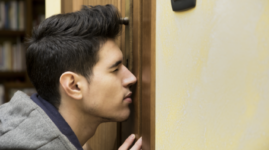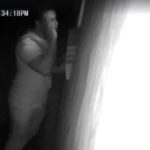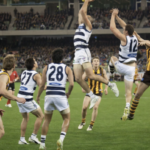Which Criminal Offences Could Apply to a ‘Peeping Tom’ in NSW?

A Queensland man was convicted last month for watching and filming several women through the windows of their homes for sexual gratification.
51-year old John William Goodwin pleaded guilty in Brisbane District Court to over 20 criminal charges relating to 12 females between the ages of 15 and 49 years over the unauthorised conduct.
After hearing about the circumstances of the case and Mr Goodwin’s subjective (personal) factors, the sentencing judge adjourned the case for several weeks for the ‘peeping Tom’ to be assessed for his suitability for an alternative to full-time imprisonment.
The case will be brought back before the court later this month.
But what does the law say about conduct associated with ‘peeping Tom’s’ in New South Wales?
And more specifically, can it amount to a criminal offence in our state.
What Is sexual voyeurism?
Voyeurism involves becoming sexually aroused by watching an unsuspecting person who is disrobing, naked, or engaged in sexual activity.
In voyeurism, it is the act of observing (peeping) that is arousing, not sexual activity with the observed person. Voyeurs do not seek sexual contact with the people being observed. When voyeurs observe unsuspecting people, they may have problems with the law.
Sexual voyeurism can constitute a mental disorder if it causes significant distress for the individual or leads to criminal offending.
The offence of voyeurism
The offence of voyeurism is outlined under section 91J of the Crimes Act 1900. This offence applies if a person:
- Observes a person who is engaged in a private act;
- For the purpose of obtaining sexual arousal;
- Without the consent of the person being observed to being observed for that purpose; and
- Knowing that the person being observed does not consent to being observed for that purpose.
A person will be engaged in a ‘private act’ if they are in a state of undress, using the toilet, showering or bathing, engaged in a sexual act of a kind not ordinarily done in public, or engaged in any other like activity, and the circumstances are such that a reasonable person would reasonably expect to be afforded privacy.
The maximum penalty for this offence is a fine of $1,100, imprisonment for 2 years or both.
An aggravated offence applies if:
- The person whom the offender observed was a child under the age of 16 years; or
- The offender constructed or adapted the fabric of any building for the purpose of facilitating the commission of the offence.
The maximum penalty for the aggravated offence is imprisonment for 5 years.
The offence of peeping or prying
Section 547C of the Crimes Act 1900 contains the offence of ‘peeping or prying’ on another person.
This offence applies if a person, who is in, on or near a building without reasonable cause with the intent to peep or pry upon another person.
The Act does not contain a definition of ‘peeping’ or ‘prying’, but generally:
- ‘Peeping’ refers to looking at something through a narrow opening (such as between blinds); and
- ‘Prying’ refers to a general intrusion into private space.
This offence carries a maximum penalty of a fine of $220 or imprisonment for 3 months.
Filming private parts without consent
Filming a person engaged in a private act is an offence under section 91K of the Crimes Act 1900, which carries a maximum penalty of 2 years in prison.
To establish the offence, the prosecution must prove beyond reasonable doubt that:
- A person filmed another person,
- The person was engaged in a private act,
- The filming was sexual arousal or sexual gratification,
- The person who filmed the other did not have the other person’s consent to undertake the filming, and
- The person knew he or she did not have consent to undertake the filming.
A ‘private act’ is defined as a state of undress, using the toilet, showering or bathing, a sexual act of a kind not ordinarily done in public or any other like activity.
The maximum penalty increases to 5 years in prison where:
- The person filmed was under the age of 16, or
- A device was installed for the purpose of the filming.
Recording an intimate image without consent
Section 91P of the Crimes Act 1900 outlines the offence of a recording an intimate image without consent.
This offence applies if a person intentionally records an intimate image of another person:
- Without the consent of the person; and
- Knowing the person did not consent to the recording or being reckless as to whether the person consented to the recording,
An ‘intimate image’ means:
- An image of a person’s private parts, or of a person engaged in a private act, in circumstances in which a reasonable person would reasonably expect to be afforded privacy; or
- An image that has been altered to appear to show a person’s private parts, or a person engaged in a private act, in circumstances in which a reasonable person would reasonably expect to be afforded privacy.
The maximum penalty of this offence is a fine of $1,100 or imprisonment for 3 years or both.
Legal defences
In the event the defendant is able to raise evidence of a legal defence to any of the above charges, the prosecution then shifts to the prosecution who are required to prove beyond a reasonable doubt that the defence is not available.
If the prosecution is unable to do this, the defendant must be acquitted; in other words, found not guilty.
The main legal defence in these cases duress, which is where the defendant forced to engage in the act under a serious, imminent and continuing threat.
Going to court?
If you are going to court over allegations of voyeurism, peeping or prying or recording an intimate image without consent, call Sydney Criminal Lawyers on (02) 9261 8881 to arrange a free conference with an experienced defence lawyer who will advise you of your options and the best way forward, and fight for the optimal result.






